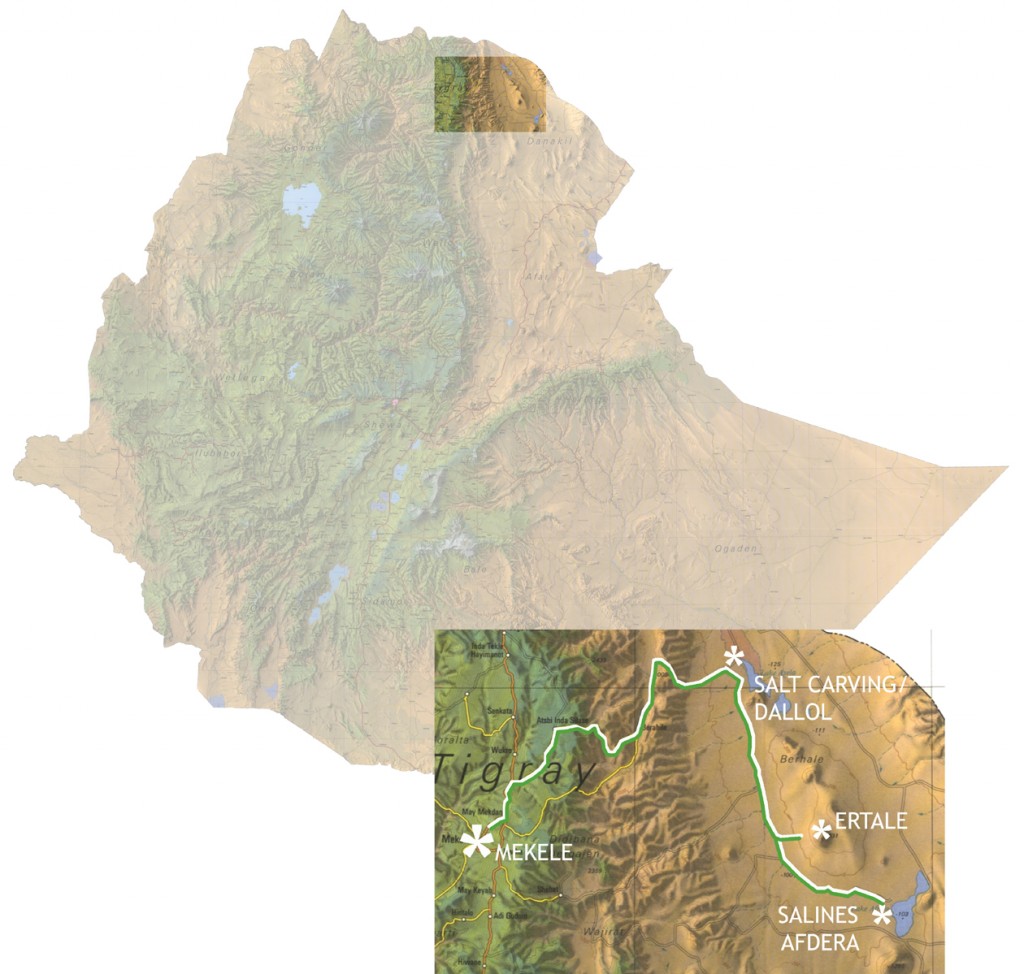The Afar are proud, nomadic Muslims who make their living from their herds of cattle and camels. Their dry, barren land stretches from the Awash River to the deserts in the far northeast of the country in the Danakil Depression. Here is the lowest point of Africa where the terrain is as low as 100 metres below see level. The climate is incredibly hot and desert winds sweep across the horizon. Nothing grows here and nothing lives. The landscape is surreal – wide and empty. Still for centuries the Afar return to this extremely harsh and inhospitable place to carry out an important job.
Thousands of years ago the Danakil Depression was flooded and was actually part of the Red Sea. After time, bending of the coast cut off the connection to the sea. The waters dried up and left a thick layer of salt in the soil several metres thick. The camel caravans of the Afar people have been travelling here for generations in order to extract the precious salt from the soil. The salt is collected from the ground in large blocks, which are stacked together and loaded on the backs of the animals. Once all the camels are loaded the caravan sets off. Day long marches along ancient caravan routes lead up to the distant markets of the highlands where the Afar sell the salt in bars called ‘amoli’. In early years the ‘amoli’ served as a form of currency. In very remote areas it is still used as a common method of payment.
The drive from the green, fertile highlands down to the desert is exceptionally beautiful. Within one single day, you can move between an elevation range of approximately 2,000 metres and the landscape changes continuously. Cacti and thorn bushes grow along the slopes, huge red rock formations rise like towers, gravel hills and sand abound. The dwellings of the people living here also change. Stone huts are replaced by minimalist buildings made from scrap wood and woven mats. And from the rocky desert comes the salt desert.
The highlight of the scenery can be found in the incredible but bizarre salt formations of Dallol, an area close to the dry salt lakes where the Afar collect the salt. Another day’s journey leads to Ertale, the volcano with the world’s only permanent active lava lake.
.
Itinerary & Travel Time: A minimum of five days should be reserved for a trip to the Danakil Depression (including a tour of Dallol, the salt mining site and Ertale, exclusive of the salines of Lake Afdera) provided that Mekele is the starting point of the trip. A detailed description of the itinerary can be found at OUR TOURS: A Short Trip to the Moon – 5-Day Expedition in the Danakil Depression.
Travel Season: From November to March. Tours do not normally operate in other months due to the high temperatures.
Meals & Accommodation: Nights will be spent in the Afar village Hamed Ela, which is close to Dallol and the dry salt lakes. There is not a conventional hotel, but rather traditional huts on the edge of the village where local-style beds are placed under the open sky. These huts are used and reserved for tourists only. Sanitary facilities are not available, but water for washing can be arranged. Sufficient food and drinking water must be brought with you. Our cook will take care of that and prepare your meals for you. On an excursion to the Ertale volcano a night is also spent camping out in the open air near to the crater rim of the volcano.
Note: Due to the extreme conditions of the Danakil Depression it is necessary for travellers to be physically fit.
Note: There is currently a foreign security warning for travel to the Danakil Depression (see foreign travel information online, e.g. the UK government travel website). For your own safety during an expedition a security escort, usually local guides and two or more soldiers resp. police officers, is mandatory for certain parts of the tour.
.
.

